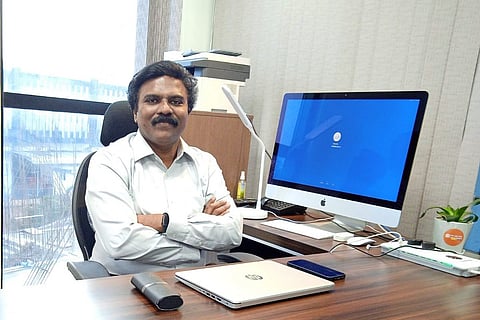K-FON, Kerala’s affordable internet, is ready for launch: Project head
A week ago, Kerala’s Chief Minister Pinarayi Vijayan announced that the state has become the first in the country to digitise all its banks. He added that 90% of the work on K-FON – Kerala Fibre Optic Network – the project that is meant to make internet affordable for everyone is also done. The project was announced in 2019. Santhosh Babu, who heads the K-FON project, tells TNM that it is expected to be launched within weeks.
“The Chief Minister will decide when, but it is expected to happen soon,” Santhosh says and rattles off numbers – the government offices it has already been installed at, the networks laid, the kilometres covered across Kerala, all of it waiting for the switch to go on and internet to flow. The physical work of laying the cables has been going on. On a piece of paper, Santhosh draws an eight, explaining the ring architecture that has been used.
Across Kerala, there are 375 Points of Presence or POP, he says. POP is the point where one or more networks connect to another. The eight he drew tells you that if the connection breaks through one end, the other end will still be on. Of course, there is a possibility that the connection can go out on both ends. Santhosh stresses on this because it is important to understand that what people need is internet that lasts, not one that comes at an affordable rate and then breaks every few minutes.
The original idea of K-FON was to connect 30,000 government offices across the state. The Kerala State Wide Area Network that has so far been used for e-governance is limited to only 3,800 offices. In its plan to expand the network, the government decided to use the Kerala State Electricity Board Limited (KSEBL) infrastructure to set up the network. Both KSEBL and the Kerala State Information Technology Infrastructure Limited (KSITIL) became equal partners in the project.
However, the idea expanded over the years, Santhosh says. “The government said in its manifesto that it will include 20 lakh families, in addition to the government offices. The offices too added up to around 37,500 later. We have finished laying the fibre across 25,000 of the 30,000 km of the network. The remaining could not be laid because of road expansion. We have also installed end office equipment in 26,126 government offices, out of which more than 12,000 including the K-FON office are already enjoying internet connection. In another 15 to 20 days, we will connect up to 18,174 more offices and the rest after the road widening is over.”
Selecting the families
The responsibility of selecting the 20 lakh families that would enjoy the project went to the Local Self Government Department. It would start with 14,000 families, with a hundred families selected from each of the 140 Assembly constituencies. The families are chosen by the respective Members of the Legislative Assembly (MLA) in consultation with the local self governing bodies, among wards that contain more number of families belonging to Scheduled Castes/Scheduled Tribes. Priority in selection is as follows: Families belonging to the ST community falling Below Poverty Line (BPL) with school children and followed by BPL families with school children belonging to SC community.
After that priority is given to BPL families belonging to ST community having college-going members, followed by BPL families belonging to SC community with college students. The next priority will go to BPL families that have one or more members with at least 40% disability, and finally the other BPL families that have school-going children.
Santhosh says that the physical connections have been done for 6,000 of these families and they will get internet service the day the government announces the K-FON launch.
Monetising the network
A Network Operating Centre at the Infopark in Kochi enables the team to monitor all the project activities, find out which of the POPs are functioning, where the connections are getting cut, and so on. Out of the 375 POPs, 300 are functional now. Each POP is within a KSEB substation.
“At this stage, we are slowly moving from the implementation phase done by KSITIL to the operation maintenance (O&M) phase done by K-FON,” says Santhosh who is the Managing Director of both offices. The catch is that while the implementation by KSITIL was funded by the government and KIFFB (Kerala Infrastructure Investment Fund Board), the O&M part will not be funded. So Santhosh and team, with the help of a committee headed by Chief Secretary VPJoy, have figured out ways to monetise the network. This includes monetising the dark fibre, charging for the internet use in government offices (where they now pay multiple service providers), leasing internet lines (to other service providers), and even setting up OTT or IPTV platforms.
To a question if this will affect the original objective of the project – providing affordable internet for all – Santhosh says that will still happen. Apart from the 20 lakh families, internet shall be made available through Wi-Fi in public places, though this will also generate ad revenue. The money to run the network will come just from monetising the dark fibre and providing the service through a tender, in addition to the various other steps he mentioned.
Being the largest network (even Jio has covered only about 10,000 km underground), Santhosh is confident that K-FON will be the most sought after one.

